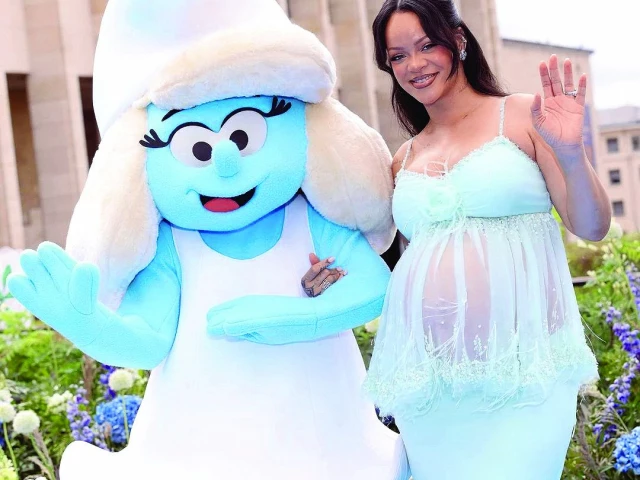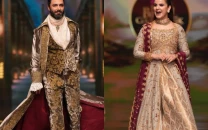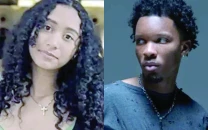Can Rihanna save the Smurfs?
Even with the megastar on board, it's still a boys' club

Papa Smurf has been mysteriously captured by evil wizards Gargamel and his brother, Razamel. As the only female in her village of male Smurfs, Smurfette is taking the lead in the new adventure of the little blue humanoids.
Smurfs, an animated musical film released on July 18, stars Rihanna as Smurfette. The megastar also co-produced the film and released an original song for the film's soundtrack in May, reports DW.
Since it was Rihanna's first new track in three years — following rumours that the pop star was retiring from music — it was big news for her fans.
But reactions were mixed: Even though many of them celebrate Friend Of Mine as "a club banger," others were disappointed to see her return with a song for a kids movie.
The Grammy-winning artist-turned-entrepreneur, who's also pregnant with her third child, is generally seen as a symbol of Black female empowerment.
Yet even though the new Smurfs film gives Smurfette an empowering role, the character's name is nevertheless synonymous with an entire sexist pop culture trope: the Smurfette principle.
The concept, which was coined in 1991 by feminist critic Katha Pollitt in a New York Times article, refers to a pattern that can still be widely observed in films, TV series or video games: a single female character is surrounded by an otherwise all-male ensemble of heroes.
Beyond the Smurfs, the trope can be observed in many other popular universes, from Princess Leia in Star Wars to Miss Piggy in The Muppets, from Kanga in Winnie the Pooh to Peach in The Super Mario Bros. Movie.
Reversing the Smurfette principle
Reflecting Hollywood's endless cycle of reboots, spin-offs and sequels, the 2025 Smurfs film follows three other US-produced features in the franchise, all based on the series first developed in 1958 by Belgian comic artist Peyo.
The live-action animated film from 2011, The Smurfs, reflects on the problematic gender imbalance of the Smurf universe when Gargamel plays with puppets representing the creatures he's obsessed with: "I'm Papa Smurf," he sneers, using a ventriloquist voice as he waves around a blue puppet with a red cap. "I have 99 sons and one daughter — nothing weird about that!"
Smurfette's original sexist backstory is also revisited in The Smurfs 2 (2013): She was not initially part of the village, but rather created out of clay by Gargamel, who devised her as an evil spy to infiltrate the Smurf community. But once Smurfette gets to know the Smurfs and discovers how open and friendly they are, she disowns her master, and Papa Smurf transforms her into a real Smurf.
The spell also metamorphoses her into a more stereotypically feminine character: Her unkept black hair is turned into lush blonde locks; her generic Smurf slippers and simple elongated tank top are also magically restyled as high heels and a frilly dress.
The Smurfette principle is most directly tackled in Smurfs: The Lost Village (2017). Smurfette searches for her purpose, seeing that the other Smurfs around her all have a name describing their identity: Brainy, Clumsy or Sleepy. In her self-discovery journey, she lands in a village of all-female Smurfs.
But that attempt to reverse gender roles also drew criticism: "I'm all for empowering girls, but not at the detriment of boys. I did not like the way the boy Smurfs were portrayed as bumbling idiots," wrote one parent reviewing Smurfs: The Lost Village on Common Sense Media.
Film critic Maryann Johanson saw things similarly. The film "seems to believe it is feminist, but only doubles down on Smurfily regressive notions of gender," she wrote, by "embracing the gentler form of misogyny that puts women on a pedestal."
Others pointed out that introducing the new female characters feels more driven by profit than by feminist values by merely expanding options for Smurf merchandising: "It's extremely obvious that Smurfs: The Lost Village exists to create a base for a new Smurfs universe that's more or less the same as the old one, except with more girls — and, presumably, more little girls in the audience too," correctly predicted a Vox critic reviewing the film at the time. An animated TV series with the female characters followed the film and is still running.
Co-opted by far-right?
Meanwhile, the Smurf brand is also facing other challenges beyond gender issues.
In Germany, the creatures have been co-opted by content creators promoting far-right populist views. AI-generated videos set in the Smurf universe started circulating on social media platforms last year that computer-manipulated the original narrator's voice to criticise, for instance, a supposed "woke dictatorship."
Collectible Smurf figurines were also spotted at election campaign events for the far-right Alternative for Germany (AfD), whose party colour is also light blue.
"We take this brand misuse very seriously," stated IMPS, the rights holder of the Smurfs, in a press release reacting to the videos created without permission.
"In particular, we clearly distance ourselves from the content of these postings and their right-wing populist context;" he added. "The Smurfs are a symbol of childhood and innocence. They stand for values such as tolerance, respect and friendship and must not be misused in any way for purposes that are contrary to their values and history."
French political commentator Antoine Bueno also sparked controversy with his 2011 book analysing the symbolism of the Smurf universe. The author argued that the Smurf society contains overtones of Stalinism and Nazism, and that the evil figures could be read as antisemitic caricatures.
However, Bueno clarified that he didn't believe that the creator of the Smurfs had deliberately added the racist overtones to his stories, he told The Guardian at the time: "Peyo was not at all politicised; all this was unconscious."





















COMMENTS
Comments are moderated and generally will be posted if they are on-topic and not abusive.
For more information, please see our Comments FAQ